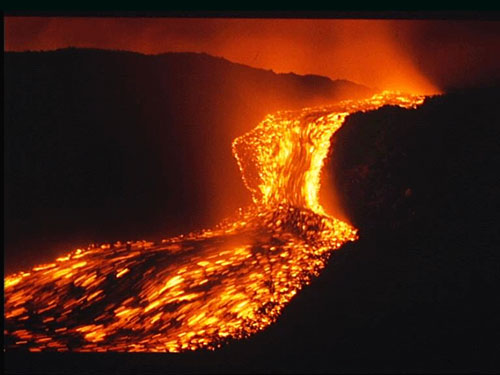Going back to the distant past
In order to date old geological material, geologists rely on radionuclides whose period
whose period (half life) is between a few hundred of thousand and a few million of years. The decrease of these elements, of which the most known is uranium-238, plays the role of the timer.
(half life) is between a few hundred of thousand and a few million of years. The decrease of these elements, of which the most known is uranium-238, plays the role of the timer.

The eruption of Etna
A stream of lava coming from one eruption of Etna. Ancient lava flows are dated using the Potassium- Argon method. As soon as the magma becomes solid, its potassium -40 atoms are trapped. Following this, they slowly transforms due a radioactivity decay into argon atoms that remainalso trapped in the rock. The old lava age is then given by the proportion found of both elements.
© CEA
The dating of lava, using the Potassium-Argon technique is an example of the use of geology of these radioelements. Potassium is a abundant chemical element of which one of the radioactive isotope – potassium-40 – exists in its natural state. Its long life makes it an excellent timer to measure the age of ancient lava. Argon-40, which is a noble gas, is one of the two products of disintegration of this potassium.
When a nucleus of potassium-40 (40K) present in a rock crystal, disintegrates in argon-14, this isotope – gaseous- stays trapped in the crystal residue. It is only freed when the mineral is melted or heated.
At the moment when the lava is crystallised into a solid, it contains a specific amount of potassium but not argon. The latter accumulates during the very slow disintegration of the potassium-40, the period of which is 1,26 billion years . The quantity of argon, built up in the rock from when it first solidified, measures the age of the lava. It is necessary that the rocks do not contain argon at the time of its formation, and do not let the gas escape during time. The method applies to feldspath and mica found in volcanic rocks.
The dose of potassium-40 and argon-40 requires the use of refined mass spectrometry carried out in specialised laboratories. This method allows the dating of lava and volcanic rocks whose age varies from between 100 000 years and 2 million years. Other techniques allow the dating of extraordinary very varied ages. For example, the Uranium-Lead method allows measuring the age of 4.5 million of years on earth, and that of Uranium-Thorium to evaluate up to several hundred of thousand of years of recent geological years like those of corals.
Other articles on the subject « Radioactive Dating »
Radiocarbon Dating
Find the age of a bygone object by counting Carbon-14 decays The most common of the radioactive d[...]
Thermoluminescence
Dating by releasing the energy stored by the radioactivity Many minerals emit light when heated. [...]
Wine Authentication
How to use radioactivity to authenticate a vintage Large quantities of artificial radionuclides f[...]